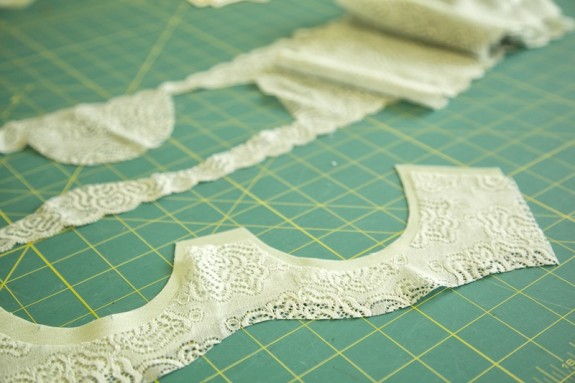
The time has come to cut our bras!
By now if you’ve been making tester bras or alterations you probably know your bra pattern inside and out. And that’s a good thing! Understanding a pattern makes sewing so much easier, don’t you think?
Before I start cutting, I like to double-check a few things on my pattern:
Check the cradle seam to make sure it has enough length for your chosen underwire. The cradle seam should be the length of your underwire PLUS 5/8″ (or 16 mm).
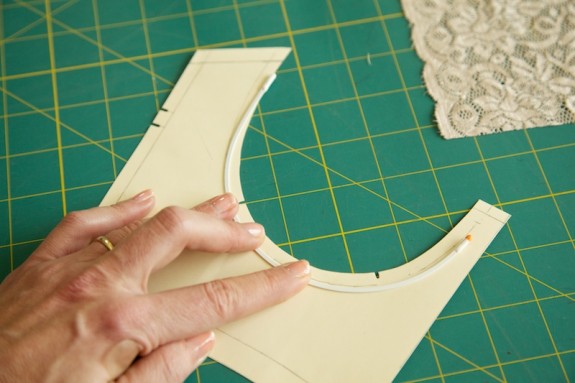
This extra length gives your wire about 8mm wiggle room on each end (called “wire play” in bra drafting). If you have ever tried to sew a bra without that allowance, you might know the pain of breaking a needle because you hit the wire while sewing down elastic (CHECK!) or your wires have strained and popped the channeling seam (CHECK!). If you end up needing more length you can add a bit more to one side or the other, or both. Don’t forget you’ll have to add this new length to the corresponding cup seams.
The distance between the cradle and elastic seam lines should be at least the width of your band elastic (otherwise you’ll be sewing elastic into your cup!).

After that, it never hurts to walk your seams in your cups and cradle to make sure the actual stitching lines match–especially if you’ve been making alterations!
lining or interfacing
You may have already figured this out in some of your tester bra experiments, but there are many ways to stabilize a cup and remove some of the stretch. You can either sew a lining underneath your main cup fabric, interface it, or both!
For my bra, I’m cutting my entire cup and cradle out of lace and lining it with silk. I really wanted to try silk on this bra!
For stability, I interfaced the silk with a fusible knit. You can see I blockfused my fabric before cutting. I’m a fan of blockfusing, especially when it comes to small pieces that get finicky and time-consuming to interface.
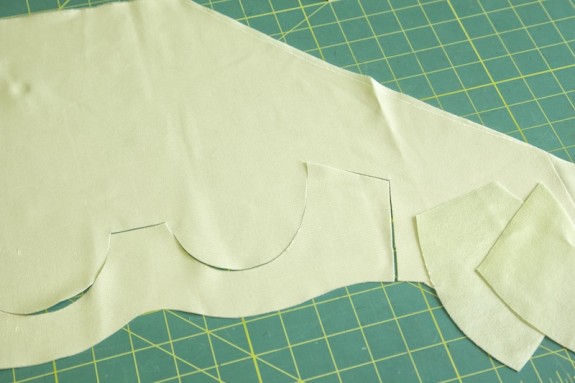
For my friend’s bra, I’m using simplex from a bra kit with lace on the top cup. I’m new to this fabric and debated over whether to fuse it–it’s stable but has a lot of drape which I suspect will make the cup drop a little. She’s definitely going to get another bra after this anyway!
The cradle or bridge area should not stretch at all horizontally. Again, I don’t think a lining is necessary for simplex but I went ahead and cut one out of sheer tricot.
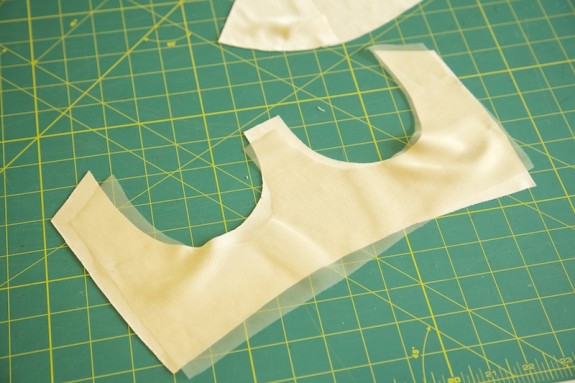
stretch directions
All of your pieces should have a line which indications the stretch direction. Bra fabrics can have their greatest stretch in either direction, so test your fabric to be sure! Even the more stable bra fabrics have some mechanical stretch.
Regardless of the pattern, I usually cut my upper cups with the neckline running parallel to the stretch. Unless I’m stabilizing it, I don’t really want this piece stretching up and down as it will stress the strap, nor on the bias which tends to permanently stretch.
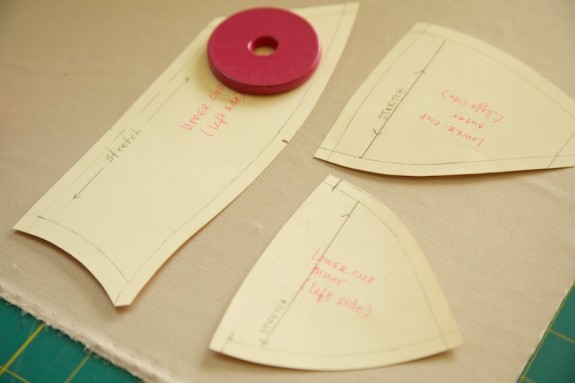
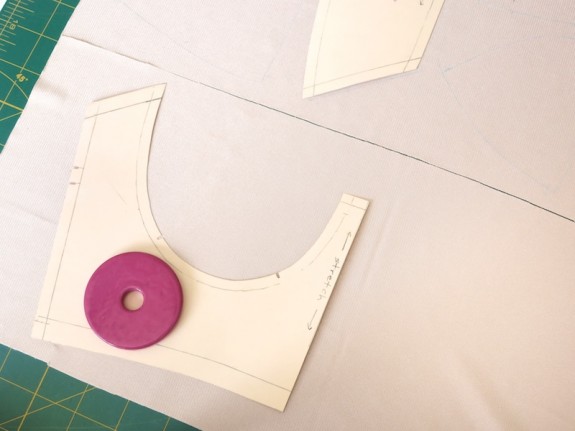
If you are using lace, 4-way stretch fabric or a print that you want to run in a particular direction, it can be lined or interfaced to stabilize it.
cutting lace
There are many ways to use lace in a bra and I really love working out lace puzzles!
When cutting the lace, it is helpful to have your seam lines marked in your cup and cradle pattern. I usually cut one side of the cup first to center the motifs. I make sure the stitching line of the upper cup is lined up with the lowest point of the scallops:

I also try to line up the piece so that the stitching line that meets the bridge hits a bottom point of a scallop. When the bridge and cup are sewn together it will match up nicely:
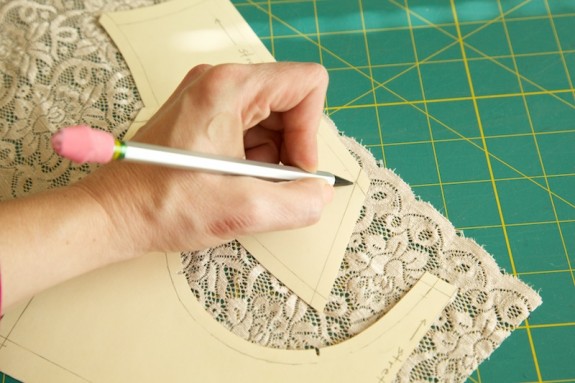
I usually cut one side first, then flip over the cup pieces to cut another mirroring side. It just so happened I have a 2nd pattern piece that I can flip:

But often when I’m cutting a bra, I simply cut the first piece, flip it to find a matching side and carefully run a rotary cutter around it.
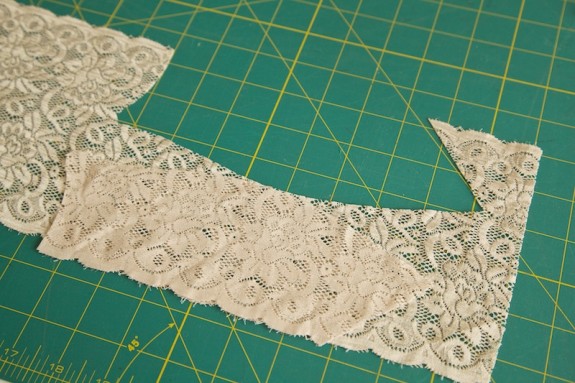
Some galloon laces have mirroring motifs, some don’t. If not, I try to get close so the motifs are similar on both sides.
All cut!
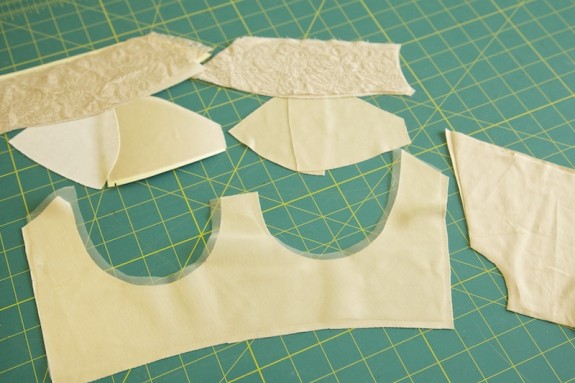
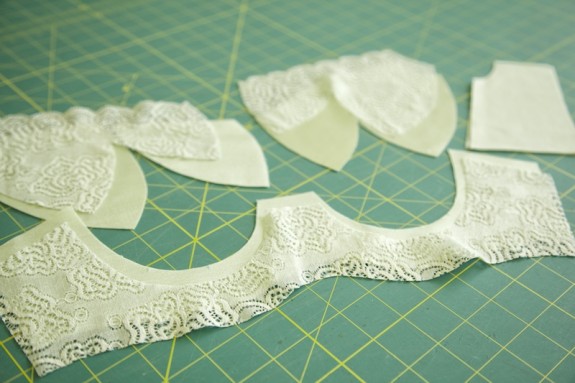
cutting notes
I mentioned this before, but I like to transfer my master pattern to something like card stock or in this case oak tag (same paper as manila file folders). I’ve even scanned my pattern so I can print it out multiple times onto weightier paper. (No more re-tracing!) This not only preserves the pattern but gives me an edge on which to trace around with tailor’s chalk directly onto the fabric:
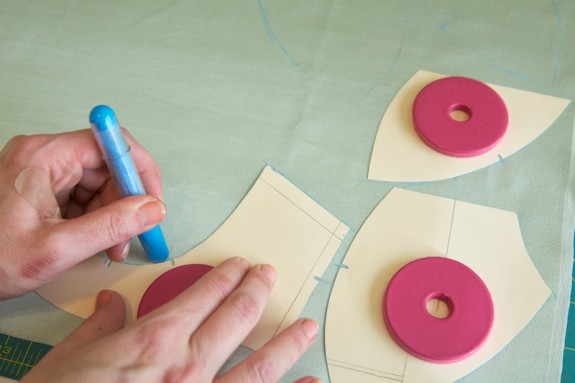
I use a small weight (or just my hands!), chalk around the pattern, then cut away the chalk lines. I like doing it this way because it gives me a really accurate cut, while pinning sometimes distorts the fabric (especially lycra and lace). This is just a cutting method that I’ve picked up from pattern-makers–it takes me all of 5 minutes to cut a bra pattern!
Would you like tips and inspiration in the craft of lingerie sewing? Sign up for my weekly eletter The Lingerie Maker.

This is all so fascinating!! I can’t wait to be in a season of life where I can invest in this kind of wardrobe creation. This sew-a-along is such a treasure resource!
Brilliant idea to scan the patterns & print them on heavier paper stock. Amy, you’ve had so many brillian ideas. Thank you for sharing them all!
Hi Amy. I posted photos of my finished bra (and panties) on my site just now: http://www.fehrtrade.com/gallery/672/champagne-black-lacy-lingerie-set I’ve included a little trick for getting the edges all nicely finished in a lined cup, I’m not sure if you’ll be covering this in your instructions or not but it’s how I’ve always assembled mine. 🙂
So many great techniques in this post – especially cutting out of the lace. This is exactly what I want to try.
My supplies and pattern should be arriving any day now, so I’ve just been going back through and re-reading your posts. One thing I’m not finding is whether I should pre-wash my fabrics. I had read somewhere (maybe a fabric site, another blog?) that you shouldn’t prewash some lingerie fabrics since they will just curl and become an unmanageable mess. Can you shed any light on this topic? Thanks.
Hi Amanda, I don’t pre-wash mine. It doesn’t seem necessary–most bra fabrics are nylon and the stretch ones have spandex. Best way to wash bras afterward is cold water with a gentle hand. (I also don’t press during construction–all the topstitching flattens everything anyway–but if you do go with a very low heat. Nylon and spandex can get damaged with heat.)
Hi Amy! Which pattern did you use to make the mint green lace bra??
Thanks so much for the amazing tutorials!
Hi Sam, thanks! Some of the pattern started out as Pin-up Girls Classic bra, but I have made a lot of modifications and alterations (you can see how I turned it into a vertically-seamed cup in this post. The lace is from Danglez.
Also, that mint green is my favorite color, where did you get the fabric!?
Hi, I missed the beginning of the bra-sewalong, but hoping in future there might
be another – who knows! an annual event lol
since discovering your blog quite by serendippity earlier today, now many hours later and I have exhausted every bit of info and links I could find related to the bra-a-thon. I wanted to say thanks so much for all your good process, most of all the sharing! and so glad your tuts are up for posterity and for me to find later on when I am feeling more confident to sew a bra – can NEVER find a comfortable one and my bust is well enough endowed that I do not feel the need at all to buy a padded garment, and unfortunately in my regional are ONLY padded bras are available because our shops ONLY stock what is in ‘fashion’ and never for those who’s only wish is to be comfortable rather than up to the minute at any price!
I have a request: what are those weights you are using and where are they available. I have long long cut my patterns on card and usually hold firm by hand but the weights look very interesting – especially as I am a dollmaker and mostly my pattern bits are small
thanks again, best wishes and heartfelt joy to you!
Hi there, thanks so much and I wish you success in your bra-making! I *think* I bought the weights at Joann Fabrics a few years ago. I can’t seem to find them anywhere at the moment–maybe they were discontinued? A lot of sewists use or cover big metal washers, which you can find at any hardware store. I like these because they’re a bit heavier than washers and don’t slide around (they are covered in rubbery plastic).But to be honest these bra pieces are so small that I often just use my hands to hold them down!
Hi Amy! I’ve been enjoying your posts immensely! I have various bra patterns and I’ve made about four but every time I’m unsure about which underwire to use. I’ve asked the bra pattern designers and they just say it’s an individual thing. So is it just a case of choosing my favourite shape underwire?
Hi Mia, wires *are* an individual thing. Before you make your next bra, try a few different wires on and find the one that fits you best. The pattern can be adjusted to fit the wire (length) later on, but it’s important you find a wire that fits or feels comfortable. It should sit comfortably right on your breast root, where your breast meets your chest wall. If you find one that fits but seems too long in the front or sides, you can always cut your wires. I wrote a post about doing that here. If the whole wire thing is still confusing you, I’d be happy to answer any of your questions via email. Hope that helps!
Our fashion teacher found weights/magnets at Harbor Freight, but they no longer have what she has. Please tell where did you got yours.
Thank you for your time,
JJ
Hi Jane, another commenter asked me about this above. They are no longer sold anywhere, unfortunately. Ordinary washers from the hardware store work well, too.